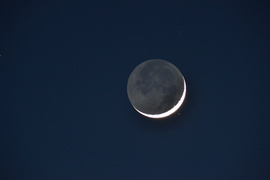This is called "the old moon in the new moon's arms" . Because you can see the part of the moon that is not illuminated by the sun. that's the "old moon'. You can see detail because sunlight reflected off the earth and onto the moon then reflects back to the earth and thus we can see the unlit part of the moon. The lighter areas are the mountains and the highlands, more rugged terrain. The darker areas are the "sea", large lave filled basins.


Enjoy being online again!
Welcome to the community of good people who base their values on evidence and appreciate civil discourse - the social network you will enjoy.Create your free account
1 comment
Feel free to reply to any comment by clicking the "Reply" button.That’s an interesting way to get light to parts of the moon (that don’t get sunlight) and then back to us.
Also happens on Earth when there is a full moon. We get the reflected sunlight from the moon.
Recent Visitors 10
starwatcher-al
Near Prescott, Az,
HumanistJohn
VA, USA
yvilletom
CA, USA
Paracosm
OR, USA
dalefvictor
Astoria,
Photos 424 More
Posted by starwatcher-alThe occultation of Mars on the 7th.
Posted by starwatcher-alThe occultation of Mars on the 7th.
Posted by starwatcher-alSolar minimum was in 2019 so the sun is ramping up in flares, spots and prominences.
Posted by starwatcher-alI missed the early phases of the eclipse but the clouds mostly left during totality. All in all a great eclipse. Next one is Nov. 8-22
Posted by starwatcher-alI missed the early phases of the eclipse but the clouds mostly left during totality. All in all a great eclipse. Next one is Nov. 8-22
Posted by RobecologyFor those following the JWST.
Posted by AnonySchmoose The post-launch set-up of the new James Webb telescope has gone very well.
Posted by HumanistJohnImages taken with Stellina (80 mm): M33 Triangulum Galaxy M1 Crab Nebula NGC281 Pacman Nebula in Cassiopeia NGC 6992 Veil Nebula in Cygnus
Posted by HumanistJohnImages taken with Stellina (80 mm): M33 Triangulum Galaxy M1 Crab Nebula NGC281 Pacman Nebula in Cassiopeia NGC 6992 Veil Nebula in Cygnus
Posted by HumanistJohnImages taken with Stellina (80 mm): M33 Triangulum Galaxy M1 Crab Nebula NGC281 Pacman Nebula in Cassiopeia NGC 6992 Veil Nebula in Cygnus
Posted by HumanistJohnImages taken with Stellina (80 mm): M33 Triangulum Galaxy M1 Crab Nebula NGC281 Pacman Nebula in Cassiopeia NGC 6992 Veil Nebula in Cygnus
Posted by HumanistJohnImages taken October 2nd 2021 with Stellina 1.
Posted by HumanistJohnImages taken October 2nd 2021 with Stellina 1.
Posted by HumanistJohnImages taken October 2nd 2021 with Stellina 1.
Posted by starwatcher-al Did you know that you can see Venus in the daytime?
Posted by starwatcher-alOne of these days I think that I'll figure out this Nikon.






